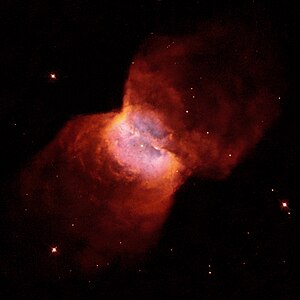| Emission nebula | |
|---|---|
| Planetary nebula | |
 NGC 2346 imaged by the Hubble Space Telescope NGC 2346 imaged by the Hubble Space Telescope | |
| Observation data: J2000.0 epoch | |
| Right ascension | 07 09 22.52166 |
| Declination | −00° 48′ 23.6112″ |
| Distance | 4,760 ly (1,458 pc) ly |
| Apparent magnitude (V) | 9.6 |
| Apparent dimensions (V) | 0.91′ |
| Constellation | Monoceros |
| Physical characteristics | |
| Radius | 2 ly |
| Designations | Butterfly Nebula, Bug Nebula |
| See also: Lists of nebulae | |
NGC 2346 is a planetary nebula near the celestial equator in the constellation of Monoceros, less than a degree to the ESE of Delta Monocerotis. It is informally known as the Butterfly Nebula. The nebula is bright and conspicuous with a visual magnitude of 9.6, and has been extensively studied. Among its most remarkable characteristics is its unusually cool central star, which is a spectroscopic binary, and its unusual shape.
The nebular is bipolar in form, with modest outflow velocities in the range of 8–11 km/s, while the center is girded by an expanding belt of molecular gas. The electron density of the nebula is on the order of 400 per cubic centimeter. The ionization of the nebula is the result of ultraviolet emission from the binary companion. The stronger infrared emission from molecular emission is coming from the belt, which is expanding at the rate of 16 km/s. The mass of the molecular gas in the nebula is estimated to be in the range of 0.34–1.85 M☉, and is much greater than the mass of the ionized gas.
The central star is a binary star consisting of an A-type subgiant and a subdwarf O star. The system, which has an orbital period of 16.00±0.03 days, is also variable, probably due to dust in orbit around it. The dust itself is heated by the central star and so NGC 2346 is unusually bright in the infrared part of the spectrum. When one of the two stars evolved into a red giant, it engulfed its companion, which stripped away a ring of material from the larger star's atmosphere. When the red giant's core was exposed, a fast stellar wind inflated two ‘bubbles’ from either side of the ring.
Gallery
References
- ^ Brown, A. G. A.; et al. (Gaia collaboration) (August 2018). "Gaia Data Release 2: Summary of the contents and survey properties". Astronomy & Astrophysics. 616. A1. arXiv:1804.09365. Bibcode:2018A&A...616A...1G. doi:10.1051/0004-6361/201833051. Gaia DR2 record for this source at VizieR.
- ^ Brown, Alex J.; Jones, David; Boffin, Henri M. J.; Van Winckel, Hans (February 2019). "On the post-common-envelope central star of the planetary nebula NGC 2346". Monthly Notices of the Royal Astronomical Society. 482 (4): 4951–4955. arXiv:1810.09764. Bibcode:2019MNRAS.482.4951B. doi:10.1093/mnras/sty2986.
- ^ Jenkins, D. A. (July 28, 2015). First Light and Beyond: Making a Success of Astronomical Observing. Springer International Publishing. p. 216. ISBN 9783319188515.
- Stanghellini, Letizia; et al. (December 10, 2008). "The Magellanic Cloud Calibration of the Galactic Planetary Nebula Distance Scale". The Astrophysical Journal. 689 (1): 194–202. arXiv:0807.1129. Bibcode:2008ApJ...689..194S. doi:10.1086/592395. S2CID 119257242.
- "NGC 2346: A Butterfly-Shaped Planetary Nebula". Astronomy Picture of the Day. October 28, 2001. Retrieved 2020-08-28.
- Sinnott, Roger W.; Perryman, Michael A. C. (1997). Millennium Star Atlas. Vol. 1. Sky Publishing Corporation and the European Space Agency. p. 249. ISBN 0-933346-84-0.
- Phillips, J. P.; Cuesta, L. (January 2000). "Extinction Mapping of the Bipolar Outflow NGC 2346". The Astronomical Journal. 119 (1): 335–341. Bibcode:2000AJ....119..335P. doi:10.1086/301170.
- Arias, L.; et al. (December 2001). "Kinematics of the Molecular Hydrogen from the Planetary Nebula NGC 2346". The Astronomical Journal. 122 (6): 3293–3304. Bibcode:2001AJ....122.3293A. doi:10.1086/324446.
- González-Santamaría, I.; Manteiga, M.; Manchado, A.; Ulla, A.; Dafonte, C.; López Varela, P. (2021). "Planetary nebulae in Gaia EDR3: Central star identification, properties, and binarity". Astronomy & Astrophysics. 656: A51. arXiv:2109.12114. Bibcode:2021A&A...656A..51G. doi:10.1051/0004-6361/202141916. S2CID 237940344.
- Samus', N. N; Kazarovets, E. V; Durlevich, O. V; Kireeva, N. N; Pastukhova, E. N (2017). "General catalogue of variable stars". Astronomy Reports. 5.1. 61 (1): 80. Bibcode:2017ARep...61...80S. doi:10.1134/S1063772917010085. S2CID 255195566.
External links
 Media related to NGC 2346 at Wikimedia Commons
Media related to NGC 2346 at Wikimedia Commons
